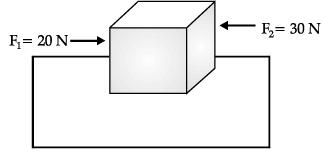Test: Force and Laws of Motion- Case Based Type Questions - Class 9 MCQ
15 Questions MCQ Test - Test: Force and Laws of Motion- Case Based Type Questions
Direction: Read the following paragraph and choose the correct options to answer any four questions given below :
A large bus and a van, both moving with a velocity of magnitude v, have a head-on-collision and both the vehicles stop after the collision. The time of the collision is 1 sec.
Q. Which vehicle according to you will suffer the less damage?
Direction: Read the following paragraph and choose the correct options to answer any four questions given below :
A large bus and a van, both moving with a velocity of magnitude v, have a head-on-collision and both the vehicles stop after the collision. The time of the collision is 1 sec.
Q. The vehicle, which experiences the smaller momentum change is ...................
Direction: Read the following paragraph and choose the correct options to answer any four questions given below :
A large bus and a van, both moving with a velocity of magnitude v, have a head-on-collision and both the vehicles stop after the collision. The time of the collision is 1 sec.
Q. The vehicle, which experiences smaller force of impact is ....................
Direction: Read the following paragraph and choose the correct options to answer any four questions given below :
A large bus and a van, both moving with a velocity of magnitude v, have a head-on-collision and both the vehicles stop after the collision. The time of the collision is 1 sec.
Q. The vehicle, which experiences the greater acceleration is .....................
Direction: Read the following paragraph and choose the correct options to answer any four questions given below :
A large bus and a van, both moving with a velocity of magnitude v, have a head-on-collision and both the vehicles stop after the collision. The time of the collision is 1 sec.
Q. Under the same conditions, if there was a heavy truck heavier than the bus, in place of van, which one will be more affected?
Direction: Study the following diagram and choose the correct options to answer any four questions given below:
In the figure below the card is flicked with a push. It was observed that the card moves ahead while coin falls in glass.

Q. Name the law which provides the definition of force.
Direction: Study the following diagram and choose the correct options to answer any four questions given below:
In the figure below the card is flicked with a push. It was observed that the card moves ahead while coin falls in glass.

Q. Name the law involved in this case.
Direction: Study the following diagram and choose the correct options to answer any four questions given below:
In the figure below the card is flicked with a push. It was observed that the card moves ahead while coin falls in glass.

Q. Give reason for the above observation.
Direction: Study the following diagram and choose the correct options to answer any four questions given below:
In the figure below the card is flicked with a push. It was observed that the card moves ahead while coin falls in glass.

Q. If the above coin is replaced by a heavy five rupee coin, what will be your observation. Give reason.
Direction: Study the following diagram and choose the correct options to answer any four questions given below:
In the figure below the card is flicked with a push. It was observed that the card moves ahead while coin falls in glass.

Q. State Newton’s first law of motion.
Direction: Observe the diagram and answer any four questions below:
Two forces F1 = 20 N and F2 = 30 N are acting on an object as shown in figure :

Q. Identify the name of this extra force and its direction.
Direction: Observe the diagram and answer any four questions below:
Two forces F1 = 20 N and F2 = 30 N are acting on an object as shown in figure :

Q. State the direction of the net force acting on the object ?
Direction: Observe the diagram and answer any four questions below:
Two forces F1 = 20 N and F2 = 30 N are acting on an object as shown in figure :

Q. Find the net force acting on the object.
Direction: Observe the diagram and answer any four questions below:
Two forces F1 = 20 N and F2 = 30 N are acting on an object as shown in figure :

Q. If the body still does not move under the application of these forces, what can be the possible reason for this.
Direction: Observe the diagram and answer any four questions below:
Two forces F1 = 20 N and F2 = 30 N are acting on an object as shown in figure :

Q. What is the unit of force?














